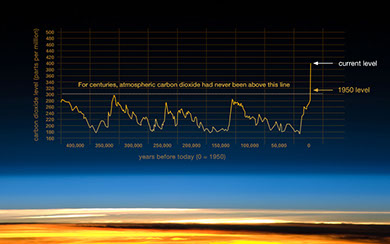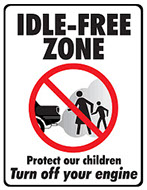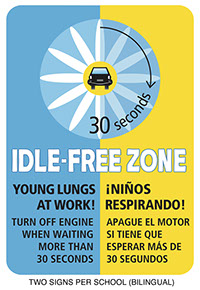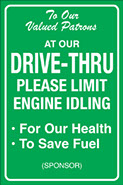IDLING
As part of Green Driving America's overall transportation efficiency advocacy, an organization focus is on the harm and waste of vehicle idling, especially when parked (discretionary idling). This is a largely unnecessary practice which impacts the planet, our health, and our wallets.
What is the problem with parked vehicles that idle?
A car is parked and idling while the driver casually browses on a mobile device, or a diesel delivery truck is idling for 15 minutes.
Eventually these vehicles go on their way and everything seems as it was before they idled. But it isn’t...
Harm has occurred: Those in the vicinity, even the drivers, have breathed toxic exhaust emissions. Our environment has been negatively impacted, from CO2 emissions into the atmosphere that contribute to climate change, to the needless use of fossil fuels. Waste has occurred: Hundreds to thousands of dollars have needlessly been expended in fuel use and engine wear from an individual's light-duty car, to a company's fleet of trucks.
Plus, laws / regulations may have been violated.
Drivers need to be aware of this harmful and wasteful yet largely unnecessary practice that occurs daily.
IDLING FACTS
The U.S. Dept. of Energy states: "Each year, U.S. passenger cars, light-duty trucks, medium-duty trucks, and heavy-duty vehicles consume more than 6 billion gallons of diesel fuel and gasoline—without even moving. Roughly half of that fuel is wasted by passenger vehicles."
FIRST, IDLING STILL MATTERS
As of 2023, an average of 85% of light-duty vehicle fuel types on the road in California's Bay Area and Los Angeles area, and 90% or more in all other parts of California and all other U.S. states were gasoline and diesel, as opposed to vehicles that seldom emit pollutants at idle or not at all: hybrids, plug-in hybrids, all-electrics, and fuel cell.
IDLING IS MONEY OUT THE TAILPIPE
FUEL WASTE: Whether a light-duty car, SUV or pickup, or commercial truck, needless idling burns hard earned dollars or company profits through the tailpipe. For example, at $3.25/gal, excessive idling of a light-duty vehicle when parked can cost $50 to $250 annually. For heavy-duty vehicles, this cost can triple. According the the Office of Energy Efficiency & Renewable Energy, "Idling an Engine for as Little as 10 Seconds Will Use More Fuel than Stopping and Restarting the Vehicle" (up to 30 seconds for heavy-duty vehicles). And for every two minutes of idling, one mile could be traveled.
ENGINE WEAR: "Ghost miles" accumulate on an idling engine. The Oak Ridge National Laboratory Summary of OEM Idling Recommendations from Vehicle Owner’s Manuals states, "Excessive idling can create engine wear and carbon soot buildup in the engine and components". This can lead to shortened life of motor oil, spark plugs and exhaust systems, plus decreased fuel mileage and the need to adhere to a "severe duty" maintenance schedule.
IDLING IS BAD FOR AIR QUALITY AND HEALTH
Overall, the latest light-duty gasoline-powered vehicles have come a long way in reducing harmful exhaust chemicals, such as carbon monoxide, nitrogen oxide, sulfur dioxide, hydrocarbons, and benzene. But this exhaust is still harmful to humans. A catalytic converter cannot render these chemical emissions less harmful until warmed up (a catalytic converter warms up faster when a vehicle is driven as opposed to idling). A caravan of idling vehicles, such as at a drive-thru or a school pickup queue greatly increases these emissions. Idling emissions are more toxic during hot and cold weather extremes. And carbon monoxide poisoning remains a threat for occupants of idling vehicles in enclosed spaces or in deep snow banks.
Diesel engines, ranging from light-duty vehicles to commercial trucks and school buses, while cleaner than those manufactured prior to 2010, still contain toxic exhaust components such as particulate matter and volatile organic compounds that cause significantly higher levels of harmful emissions when idling. Here's just the visual impact from ten minutes of idling by a RAM 2500 Turbo Diesel.
IDLING CONTRIBUTES TO CLIMATE CHANGE AND DIRTY ENERGY
CLIMATE CHANGE: Greenhouse gas emissions from vehicles, chiefly carbon dioxide (CO2), contribute to climate change. Overwhelming scientific evidence, including from the Executive Summary of the Fourth National Climate Assessment (NCA4), NASA, NOAA, the IPCC, even the Department of Defense, link climate change and global warming—in part from human activities—to the highest temperatures ever recorded on Earth, melting polar ice caps, rising sea levels, increasingly severe weather events, droughts, wildfires, flooding, and to the threat of many plant and animal species.
dioxide (CO2), contribute to climate change. Overwhelming scientific evidence, including from the Executive Summary of the Fourth National Climate Assessment (NCA4), NASA, NOAA, the IPCC, even the Department of Defense, link climate change and global warming—in part from human activities—to the highest temperatures ever recorded on Earth, melting polar ice caps, rising sea levels, increasingly severe weather events, droughts, wildfires, flooding, and to the threat of many plant and animal species.
ENERGY WASTE: Many of us are aware of conserving and saving energy, from turning off lights when leaving a room, to recycling. Turning off the keys of our parked vehicles is a simple energy conserving habit to get into.
Most of the world still relies on fossil fuels. But the decades-long transition from these dirty fuels to cleaner and renewable forms of energy cannot come soon enough. Crude oil—including gasoline and diesel fuels—is harmful to human health and to our planet, from extraction to emissions. North America in particular extracts petroleum primarily using the dirty method of hydraulic fracturing or "fracking". This causes methane gas to be released into the atmosphere—a much more insidious greenhouse gas than CO2—increasing the challenge of coming to grips with the global climate crisis.
BUT HOW IS IDLING A PROBLEM WITH TODAY'S MODERN VEHICLES?
The fact is, idling is at odds with how clean modern vehicles truly are under the following common circumstances:
• Prolonged stationary warm ups - where catalytic converters are not effective in reducing toxins until the vehicle is driven
• Idling caravans, such as in drive-thrus and school dismissals, which cause idling “hot spots”, increasing toxicity around the vehicles
• Hot and cold weather extremes, which exacerbate the toxicity of idling vehicles
And, Internal combustion engines, no matter how clean they are, still emit about 20 lbs. of CO2 for every gallon of fuel consumed.
DISCOURAGEMENT OF IDLING: STRAIGHT FROM OWNER'S MANUALS
OWNER'S MANUAL IDLING QUOTES: MOST POPULAR 2024-2025 VEHICLES
2025 Ford F-150:
“Avoid idling the engine in cold weather or for extended periods. Start the engine only when you are ready to set off.”
2025 Chevrolet Silverado 1500:
1. “Avoid idling the engine for long periods of time.”
2. “Extended Idle Use: When the vehicle is used in a way that requires extended idle time, one hour of use shall be deemed the same as 53 km (33 mi).”
2025 Toyota RAV4:
1. “Engine oil consumption: A certain amount of engine oil will be consumed while driving. In the following situations, oil consumption may increase, and engine oil may need to be refilled in between oil maintenance intervals.
● When leaving the engine idling for a long time, or when driving frequently through heavy traffic”
2. “Stop & Start system (If equipped): The Stop & Start system stops and starts the engine according to brake pedal or shift lever operation when the vehicle is stopped, such as at a stoplight, intersection, etc., in order to improve fuel economy and reduce noise pollution caused by the engine idling.”
2025 Honda CR-V:
“Achieving fuel economy and reducing CO2 factors, including driving conditions, load weight, idling time, driving habits, and vehicle condition. Depending on these and other factors, you may not achieve the rated fuel economy of this vehicle.”
2025 Ram 1500:
“Operating, servicing and maintaining a passenger vehicle or off-highway motor vehicle can expose you to chemicals including engine exhaust, carbon monoxide, phthalates, and lead, which are known to the State of California to cause cancer and birth defects or other reproductive harm. To minimize exposure, avoid breathing exhaust, do not idle the engine except as necessary.”
CAIFORNIA PROPOSITION 65:
Passenger and Off-Highway Motor Vehicles Exposure Warnings
A vehicle exhaust warning provided in the owner’s manual must be in no smaller than 12-point type and enclosed in a box AND the warning label be attached to the driver’s side front window.
““Operating, servicing and maintaining a passenger vehicle or off-highway motor vehicle can expose you to chemicals including engine exhaust, carbon monoxide, phthalates, and lead, which are known to the State of California to cause cancer and birth defects or other reproductive harm. To minimize exposure, avoid breathing exhaust, do not idle the engine except as necessary.”
FOR OWNER'S MANUAL QUOTES DISCOURAGING IDLING FOR OLDER VEHICLES, VISIT: http://idlefreecalifornia.org/owners-manuals.html
YES, IDLING CAN BE NECESSARY
For light-duty vehicles in cold and hot weather extremes, idling can be necessary for several reasons. In colder weather, warm-up idling may be necessary for adequate windshield/window/outside mirror defogging/defrosting. This can be a visibility issue even at more than 50º in the morning. Below 10º, a warm up of 1 to 2 minutes is recommended to allow thickened motor oil to fully circulate in an engine.
It is strongly recommended to seek alternatives to being in a parked vehicle in weather extremes. But if there is no place else to go, for factors of safety and health, idling may have to occur (although it can in alternating on-off cycles). This is especially true if there is an elderly person, infant, or pet in the vehicle. On a very hot day, especially if not parked in the shade, the vehicle will need to idle with windows closed and AC on.
For safety reasons, it is not recommended to turn off engines at stop lights; however, in prolonged situations such as at railroad crossings and road construction zones, it is recommended to do so.
Note: idling can be mitigated by driving a cleaner vehicle that seldom idles or not all, like a hybrid, plug-in hybrid or electric vehicle.
ADDITIONAL IDLING RESOURCES
From the Idle-Free California website:
• IDLE-FREE TIPS and WHEN AND HOW LONG A VEHICLE SHOULD IDLE: Light- medium- and heavy-duty vehicle warm-up times, idling when already warmed up, the negative impact of idling on engines, and perceived comfort and convenience factors of idling and how to minimize it.
• IDLE-FREE HANDOUTS: Handouts in various sizes from business card size, one-panel pamphlets, and full size flyers to print and distribute.
NOTE: In today's world, there may be some risk in approaching someone sitting in their vehicle that is idling when parked. Use careful judgment, and it is best to not consider approaching a driver in an idling vehicle unless prepared with a handout. It may be safer to just ignore them. If choosing to discuss the issue, be informed and polite. Most people are not aware of the harm and waste of idling. Also consider circumstances such as a pet or elderly person that needs to keep cool in an air-conditioned vehicle idling on a hot day. The same may apply for an infant or elderly person needing heat on a below freezing day. When you give a motorist one of these handouts, you become an ambassador of Idle-Free California and Green Driving America. UNDER NO CIRCUMSTANCE SHOULD ANYONE ACCOST A DRIVER THAT CHOOSES TO LET A VEHICLE IDLE FOR WHATEVER REASON. AND IF AN IDLING VEHICLE IS UNATTENDED, NEVER OPEN THE DOOR AND TURN OFF THE ENGINE! IDLE-FREE CALIFORNIA AND GREEN DRIVING AMERICA COMPLETELY DISAVOW SUCH BEHAVIOR.
• NO IDLING SIGNS: Local schools can post no idling signs; banks can post such signs at ATM drive thrus; mall owners can post
signs in parking lots. Only with an agreement of these entities, search online for "Custom Traffic Signs" to submit a custom sign order or these suggested templates:




